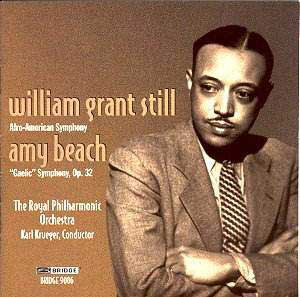William Grant Still’s experiences in Memphis, writing
band arrangements for W C Handy’s orchestra and subsequently for Eubie
Blake (where he also played the oboe) seem to have been as formative
and formidably productive as his studies with Varèse and Chadwick.
Composed in 1930 whilst he was still involved in arranging and orchestrating,
the Afro-American Symphony is an immediately attractive and expressively
scored work in four movements.
Opening with tightly muted trumpets Still employs the
black vernacular of the Blues – or a species of it – imbedded in an
orchestral sound world which in the opening Modearto assai is spare,
rather impressionistic, with subsidiary harp passages adding a Gallic
taste to the musical argument. Still’s stated purpose was to show how
the Blues "could be elevated to the highest musical level";
to this end he introduces a variational section in the first movement
followed by an expressive theme played on his own instrument, the oboe,
in the form of a spiritual. The slow movement – superscription Sorrow
– is again in sonata form, once more with oboe lines prominent,
some Delian lines flecking the score, textures augmented by bass clarinet,
for which he writes well, harp and that oboe’s continuing sinuous progress
and by some massed bluesy strings. The short third movement – an animato
– is certainly a jaunty affair with its tenor banjo ringing out Showboat-style
and adding a rather Plantation Club feel to the affair. The movement
seems to play with musical stereotypes adding hints of raunchy syncopation
and the "Red Indian" motifs so beloved in the clubs and societies
of contemporary New Orleans. The finale, Aspiration, begins as
a harmonized gospel tune with deep cellos and harp arpeggios adding
more emphatically phrased material, out of which a sonority of twilit
nobility emerges, stripped of extraneous clutter (is that a spectral
vibraharp augmenting the string lines?) The plangent oboe and bass clarinet
still manage to "speak" their songs, as the music seems to
wind down before, suddenly, bursting into renewed life for the short
final section. This is a string-laced spiritual, lashed with cross currents
of brass and, relatively discreet, percussion.
If Still’s Symphony was, to an extent, the embodiment
of Dvořák’s dictum that America should
look to its plantation and minstrel songs, or at least to its black
American music, Amy Beach sought inspiration in the heritage of the
folk songs of Britain and Ireland. Her Gaelic Symphony,
written thirty-four years before Still’s is the Bardic Symphony to end
all Bardic Symphonies. It opens in heroic style, rich in chromaticism
and mountain top horn calls before the second movement introduces the
song The Little Field of Barley – a beautiful tune, simply voiced
by Beach, repeated on the oboe with delicate woodwind accompaniment.
The light brown strings lead to a pizzicato episode and skirling fiddles
that frolic over the tune’s increasing development. It’s the third movement
in which much of the greatest power of the symphony resides. Beginning
powerfully it relaxes into the slow tread of returning pizzicati to
uncover folk melodies anew. It rises to more romantic peaks in the central
panel of the movement with its nourishingly rich violin solos and ends
in a kind of twilight gloaming, underpinned by the percussive tap, burnished
strings, winding woodwind and final, dying violin notes. The finale
reveals its debt to the central European Romantics – Schumann principally
– and does so in a rather martial way, followed by free flowing romanticism
that builds up to a forceful peroration and ends the Symphony in some
powerful splendour.
The recordings are well over thirty years old and they
sound splendid. Notes are good, in English only, and the music of these
profoundly different composers makes for constructive parallel appreciation.
I enjoyed both immensely and all praise to Bridge for this reissue.
Jonathan Woolf


